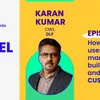How the health insurance industry is adopting a new strategy in a post-COVID world
In this episode of Pepper Content’s Top of the Funnel series, Sneha Beriwal, Head of Marketing, Product, Digital and Direct, Aditya Birla Capital Health Insurance, talks about content evolution, the impact of the pandemic, and the future of content marketing.
From FMCG to digital payments to retail and finally health insurance, Sneha Beriwal’s diverse career across industries has one principle: the consumer is at the heart of everything.
This, along with a hunger for learning and a passion for marketing, is what has allowed Sneha, now Head of Marketing, Product, Digital and Direct, Aditya Birla Capital Health Insurance, to excel across fields.
In this episode of Pepper Content’s Top of the Funnel series, we talk to Sneha about the evolution of digital marketing in her career and the role of content marketing in the health insurance industry, specifically in the post-COVID world.
The four pillars of content evolution
Sneha breaks down the evolution of content marketing into four pillars. It all started with the 30-second TV ad format where marketers were required to create short and sharp stories and get to the points fast.
With the onset of the digital revolution, the 30-second constraint gave way to a long story format and the canvas of storytelling through content opened up.
Eventually, though, just good storytelling was not enough. There needed to be platform innovation as well. This is when we saw the advent of AR or VR.
Cut to the present. Now we are in an era, where content is trying very hard not to look like content, and you see that in phenomena like influencer marketing.
“From trying to tell the brand’s point of view, it’s now all about hearing the influencer’s or endorser’s point of view on the brand. So the narrative of content has changed significantly.”
The role of content in the health insurance industry
Not just health insurance, Sneha feels that BFSI as a category has not been in line with the overall speed at which content has evolved in other industries.
The result? The need for content is higher. “At ABHI, content is a very important pillar. Since the customer is at the heart of everything, we know that content needs to add value.”
She goes on to explain that health and insurance are low mindshare categories in our country. So, to create a pull towards this sector, content is critical. ABHI invests heavily in the blog and community content with engagement as “our biggest KPI in terms of repeat visitors, subscribers, time spent, content consumed per person etc”. They also measure how much of the traffic converts into customers.
Another content pillar is the use of explainer videos and the “did you know” series to simplify the jargon around health insurance, products, and offerings.
“Finally, there is an emphasis on creating topical content to catch the customer at the right moment so that we are top of mind when it comes to health insurance. This could be FAQs around vaccination, do’s and don’ts around the recent cyclone among other things.”
Structuring a marketing team
Sneha has an interesting analogy when it comes to structuring a marketing team and the role of content within it. She likens it to building a house with three pillars. These pillars perform the three roles of “informing” the prospects about the product and services, “acquiring” them, and finally “engaging” with them.
Content is the foundation of the house, meaning every function needs to have very strong content. The roof is the breadth of media that are available to present all of this to the customer, like TV, digital, retail, etc.
The impact of the pandemic
“Health insurance was always a push category, now it is a pull category.”
The pandemic added health-specific words such as immunity and comorbidity to people’s vocabulary, and ABHI used this awareness and interest in the category itself by putting content out there that answered people’s questions.
One of the campaigns they ran - Khud Ka Health Insurance - was based on the insight that the pandemic led to job losses, which meant a loss of income plus the loss of a corporate health cover. This caught most people unawares.
“Khud Ka Health Insurance” advocated the idea that people needed to think beyond corporate health cover for two reasons: job uncertainty and adequacy. The latter because COVID also exposed that most corporate health covers are between Rs 3 and 5 lakhs - an amount that could barely cover expenses if even two people in the family became COVID-positive and needed hospitalisation.
“We saw a percentage jump in product sales.” Additionally, video views and video reach engagement also went up.
The future of content marketing
Sneha breaks it up into three phases: the now, the medium-term future, and the long-term future.
Voice, vernacular, and video are the now. The journey has begun but a lot still has to be done. In the medium term, Sneha is sure that the only way content can exist is if it’s hyper-personalised, highly contextual, and mobile-first. The one-size-fits-all approach goes away.
In the long term, content will depend on the devices that exist. For instance, what kind of content will need to be created to cater to Google Glass?
“When people will have self-driving cars, will there be a new device to consume content? As marketers, we need to ask ourselves these questions so we can be ahead of the curve.”
Edited by Teja Lele









